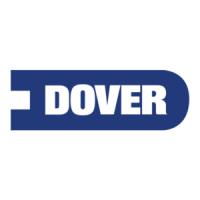WIL-12350-E-02 19 WILDEN PUMP & ENGINEERING, LLC
CLEANING — CIP
The design of the H1500 Saniflo™ HS pump allows for ease of
cleaning. The H1500 HS pump can be cleaned in place without
disassembly. Before any cleaning is attempted, ensure that the
cleaning fluids are compatible with all wetted components.
For best cleaning results consider the following information prior to cleaning the
H1500 HS pump.
• Actual CIP eectiveness with pump user’s product(s) and pro-
cesses should be validated on location by the end user’s quality
assurance personnel to meet internal guidelines. Post-cleaning
swab test is one method to accomplish this.
• The pump user should establish periodic inspections with full
tear down to verify that the CIP processes continue to be eec-
tive as rst validated.
• Inlet pressure to the pump should not be greater than 0.7 bar
(10 psig). Premature diaphragm failure will occur if greater
than 0.7 bar (10 psig) is applied. If the pump is to be subjected
to greater than 0.7 bar (10 psig), an optional diaphragm bal-
ancing device is suggested to eliminate the possibility of the
diaphragms being forced against the air chamber and subse-
quently causing premature diaphragm failure.
The following are some details to consider when cleaning the H1500 HS pump.
• The H1500 HS pump has been validated to clean equivalent to
the inlet tubing of the same diameter. The cleaning chemical
supplier should be consulted and advised of this for their chemi-
cal solution and application. The same guideline for duration of
cleaning cycle and temperature of cleaning uid apply.
• Suggested ow rate for the H1500 HS pump is 22.7 m
3
/hr (100
gpm) (usually higher is better).
• Typical CIP temperature is 77°C to 82°C (170°F to 180°F).
• Typical chemicals include NaOH (sodium hydroxide) caustic for
wash and light acid and sanitizers for rinse.
• Once an initial CIP regimen is established, it may need to be
modied to accommodate specic process and product dif-
ferences or requirements. The most common adjustments in-
clude:
• Changing cleaning time (extended or reduced pre-rinse,
wash and rinses)
• Changing cleaning ow rate
• The cleaning variables are related so that a pump user may be
able to reduce the cleaning time by increasing the ow rate or
chemical mix.
• Chlorinated sanitizers are known to cause premature failure of
stainless steel and should be avoided.
• Keep in mind, many CIP systems leave the pump lled with
sanitizer and water and do not require draining.
• To drain a pump that is tted with a non-swivel stand, the
manifolds and liquid chambers must be removed if there is no
automated CIP air-blow system in place. With the use of an au-
tomated CIP air-blow system, a pump tted with a non-swivel
stand can be cleaned in the same manner as a pump tted with
a swivel stand.
• An eective CIP system must have drain valves in the process
line before and after the pump at the lowest points. The CIP
system must be programmed to alternate between blowing air
and opening the drain valves. This process must be repeated
several times.
• Activate the CIP system while slowly cycling the pump.
NOTE: A typical the CIP temperature limit is 90°C (195°F). If the CIP
temperature is greater than 90°C (195°F), damage to the pump
may occur.

